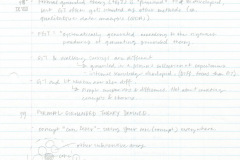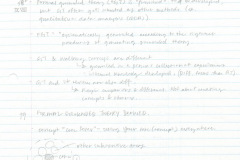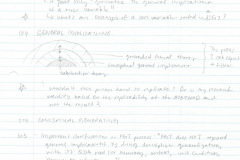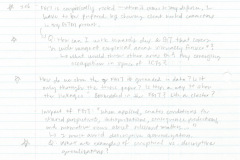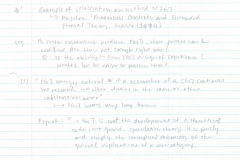
Part II: Grounded Theory Method and Formal Grounded Theory
May 7, 2020
Overall, I have a lot of questions on the abstract concepts raised by Glaser
- (97) Glaser and Strauss’ “Awareness of Dying” – what is this all about? How did GT start in healthcare?
- (98) Formal grounded theory (FGT) is “promised” to be developed, but GT often gets counted as other methods (ex. qualitative data analysis QDA)
- FGT = “systematically generated according to the rigorous procedures of generating grounded theory”
- GT and walking surveys are different; walking surveys are grounded in a person’s collection of experiences, therefore focusing on internal knowledge development
- GT and literature reviews are also different; lit. reviews produce simple comparisons and differences between concepts as opposed to creating concepts and theories
Formal Grounded Theory Defined
- (99) “Core fever” = seeing your core concept everywhere; you see what you want to see
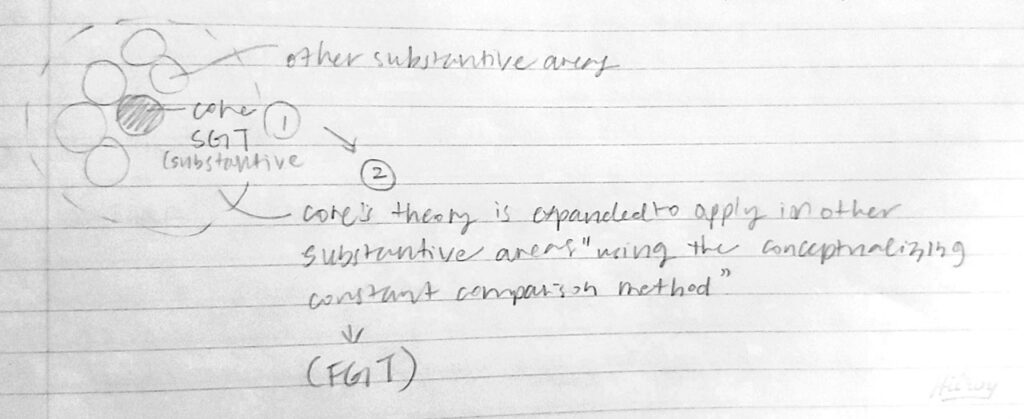
- (99) FGT = “a theory of a SGT core category’s general implications, using as widely as possible, other data and studies in the same substantive area and in other substantive areas”
- (100) FGT generalizations are conceptual; abstract of time, place, people, until application to a substantive context
- I wonder how the core category I find about UX KM can apply to other (emerging) occupations
- FGT is still grounded and shaped by data
- Criticism and defence on FGT
- Generalizing into FGT from a single case SGT may seem too simple and “particularistic”
- But, it’s to “extend the general implications of a core variable by sampling more widely in the original substantive area and in other substantive areas and then constantly comparing with the purpose to conceptualize the general implications”
- Therefore, FGT helps make the case for the core variable and its concepts stronger by showing how it can be extended to other substantive areas
- Why does this sound so… fluffy? Not sure if this sounds logical…
- “It increases the SGT breadth and depth of explanation”
- In this case, the KM of UX designers is my SGT?
Clarifying the Formal Grounded Theory Definition
- Various researchers attempt to clarify Glaser and Strauss’ explanation of SGT and FGT
- Their description on levels of generality got many researchers confused
- (102) Karen Locke’s explanation on SGT vs. FGT makes most sense to me:
In the Discovery of Grounded Theory, Glaser and Strauss make much of the difference between substantive and formal theory. They view formal theory as the sociologist’s goal. However, to be valid, they insist that it be developed from a substantive grounding in concrete social situations. Thus substantive theory is prior to formal theory, and it is closely linked to the practice domain. It represents the close connection to the empirical reality… When we speak of formal theory, however, we usually refer to those areas of inquiry that operate at a high level of generality, such as systems theory. In Glaser and Strauss’ view, substantive and formal theory are clearly related. Substantive theory can provide a link to more formal theory, but this is achieved by working empirically to develop conceptual categories at a higher level of abstraction and generality (p. 35)
Page 102
- (104) Watch out for FGT becoming a “grand theory”; it only “generates the general implications of a core variable”
- What is an example of a core variable rooted in s SGT?
General Implications
- Wouldn’t the process of FGT be hard to replicate? Or is my research validity based on the replicability of the METHOD and not the result?
Conceptual Generating
- (105) Important clarifications on FGT process: “FGT does NOT expand general implications by doing descriptive generalization, with its QDA need for accuracy, context, unit condition…”
The core category is expanded by abstract conceptual generalizations based on grounded research. The researcher uses constant comparison to generate concepts NOT to discover descriptive differences and similarities”
Page 105
- What does the above mean? What do I need to watch out for?
Application
- I can see how GTM (+FGT) is an attempt to making the natural human learning process explicit
- Goal of GT is to “construct formal theory from substantive cases”
- (106) FGT is empirically rooted; when it comes to my defence, I have to be prepared by showing clear rooted connections in my GTM process
- How can I work towards developing a GT that covers “a wide range of empirical areas virtually forever”?
- What would those other areas be? Any emerging occupation in space of ICTs?
- How do we show that the FGT is grounded in data? Is it only through the methods section of the thesis paper? Is there a way to show the linkages embedded in the FGT statement?
- Impact of FGT: “When applied, creates conditions for shared perspectives, interpretations, consequence predictions, and normative views about relevant matters…”
- I must avoid descriptive generalization
- What are examples of conceptual and descriptive generalizations?
- It seems as though FGT is one of many outcomes of GTM. So, can I / should I go this route? Is this something to consider as an option as I conduct my research?
The Pressure to Generalize
- What are the signs of over-generalization and signs of good generalization from FGT?
Method Needed
- Example of illustration on method to FGT: Anselm: Awareness Contexts and Grounded Formal Theory. Glaser (1994)
- (109) As more researchers produce FGT, their process can be codified
- Is the ability to form FGT a sign of experience? Would it be too naïve of me to pursue this now? Is FGT a long term process?
FGT emerges natural if a researcher of a SGT continues his research into other studies in the same or other substantive areas
Page 111
…FGT is not the development of a theoretical code, nor grand, speculative theory. It is purely and simply the conceptual extension of the general implications of a core category.
Page 111
